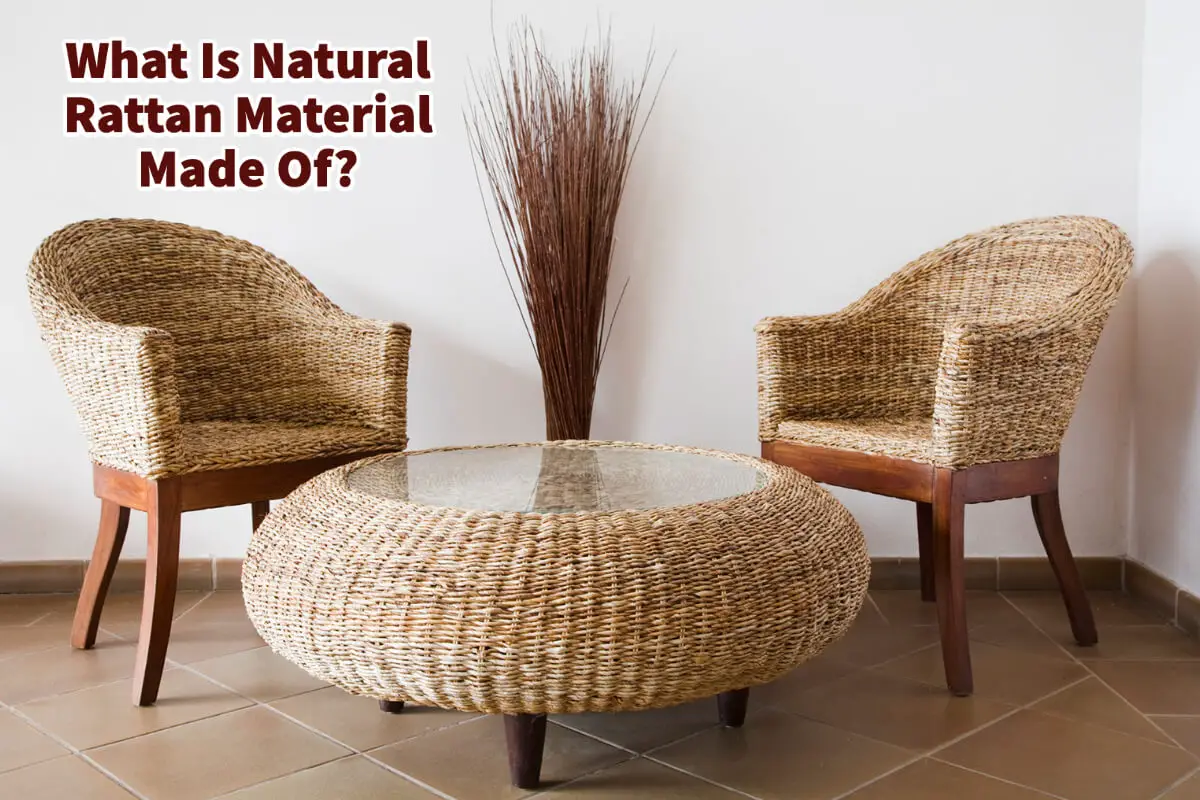In furniture and decor, rattan holds a position of esteem due to its versatile uses, assertive nature, and appealing aesthetics. But what exactly is rattan, and what is it made of?
Originating from the dense tropical rainforests, rattan is more than a material for your favorite wicker chair or basket. Read on as we guide you through the intricate journey of rattan, from its origins in the Calamoideae subfamily of the palm family to the craftsmanship involved in converting it into an array of beautiful and functional items. Join us as we unravel the secrets of natural rattan, and explore how it compares to its synthetic counterpart.
Table of Contents
- Natural Rattan: A Timeless Craft Material
- Natural Rattan Vs. Bamboo: A Comparative Study
- Natural Rattan Vs. Synthetic Rattan
- 12 Fascinating Facts About Rattan: Nature’s Versatile Wonder
- 1. Rattan is Not a Tree
- 2. Remarkable Strength
- 3. Lightweight and Easy to Handle
- 4. Versatile Crafting Material
- 5. Sustainable and Eco-Friendly
- 6. Handwoven Artistry
- 7. Natural Aesthetic
- 8. Resistance to Elements
- 9. Paint and Stain Friendly
- 10. Historical Significance
- 11. Popular in Mid-Century Modern Design
- 12. Sustainable Future
- Related Content
Natural Rattan: A Timeless Craft Material
If you’ve ever admired a beautifully crafted wicker basket, chair, or table, you’ve likely been admiring the work of rattan. Rattan has long been revered for its strength, durability, and the beautiful products it can create.
But what is natural rattan, and how is it made? And what about synthetic rattan?
The Origins Of Natural Rattan
Rattan hails from the Calamoideae, a large subfamily of the palm family (Palmae or Arecaceae). The rattan family exhibits a remarkable variety with a diversity of approximately 600 different species spread across 13 genera.
This humble climbing palm thrives in the tropical regions of Africa, Asia, and Australasia, where it grows prolifically in the rainforest’s understory, often reaching lengths of up to 200 meters.
Despite its vine-like appearance, rattan is a solid wood. This unique structure differentiates it from bamboo, another popular crafting material, which is hollow in the middle.
The solid nature of rattan provides it with strength and resilience, making it a favorite material for a wide range of products, including furniture, baskets, mats, and even walking canes.
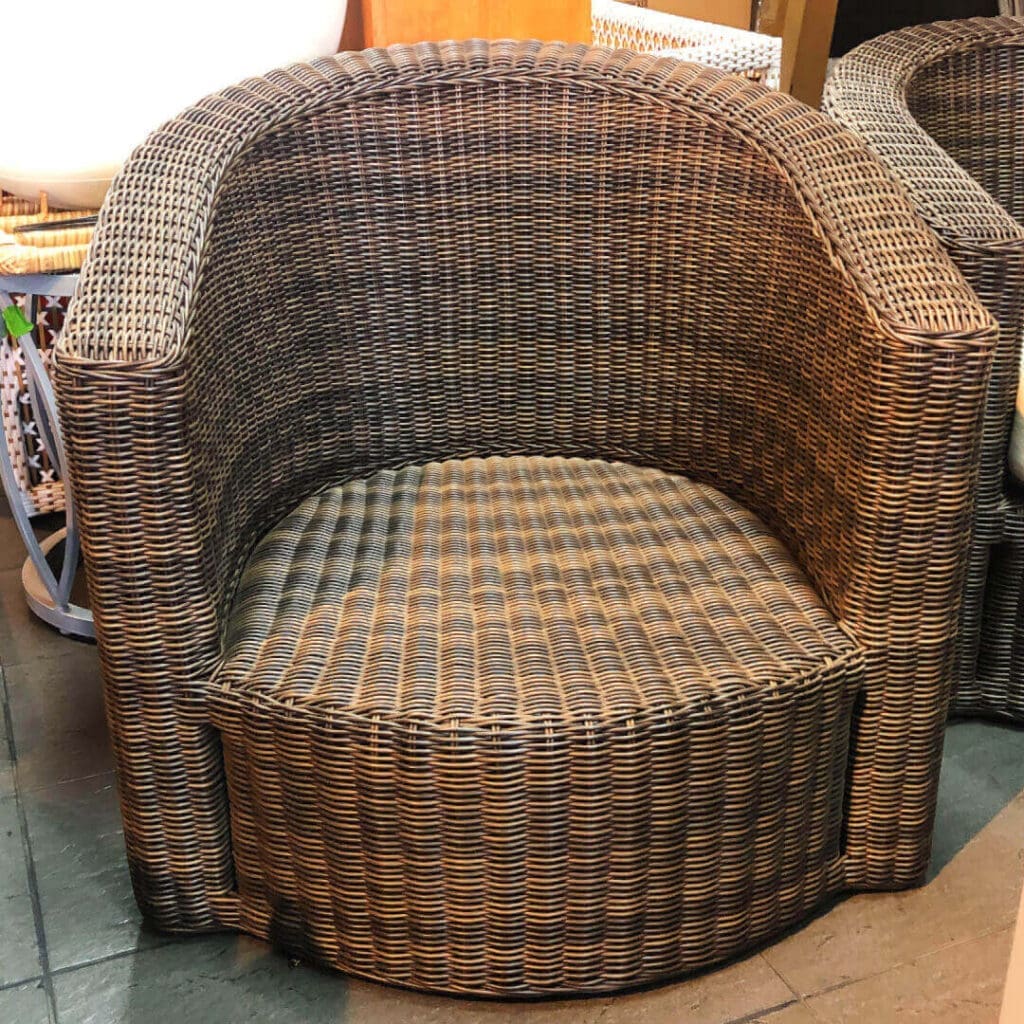
The Making Of Rattan
Creating usable rattan begins in the forests, where harvesters cut the rattan canes into manageable lengths. The rattan’s outer skin, rich in silica, is stripped off, revealing the inner core used for weaving.
The canes are then usually treated with heat to make them more pliable, allowing them to be shaped into various forms without breaking. Once shaped, the rattan can cool and harden, retaining its new form.
From here, artisans can weave the rattan into various products, creating durable, lightweight, and beautiful pieces of work.
Natural Rattan Vs. Bamboo: A Comparative Study
Rattan and bamboo are popular materials used in furniture production and other applications. While they may seem similar initially, they have distinct characteristics, benefits, and drawbacks. Let’s look at these two unique materials to understand their similarities and differences better.
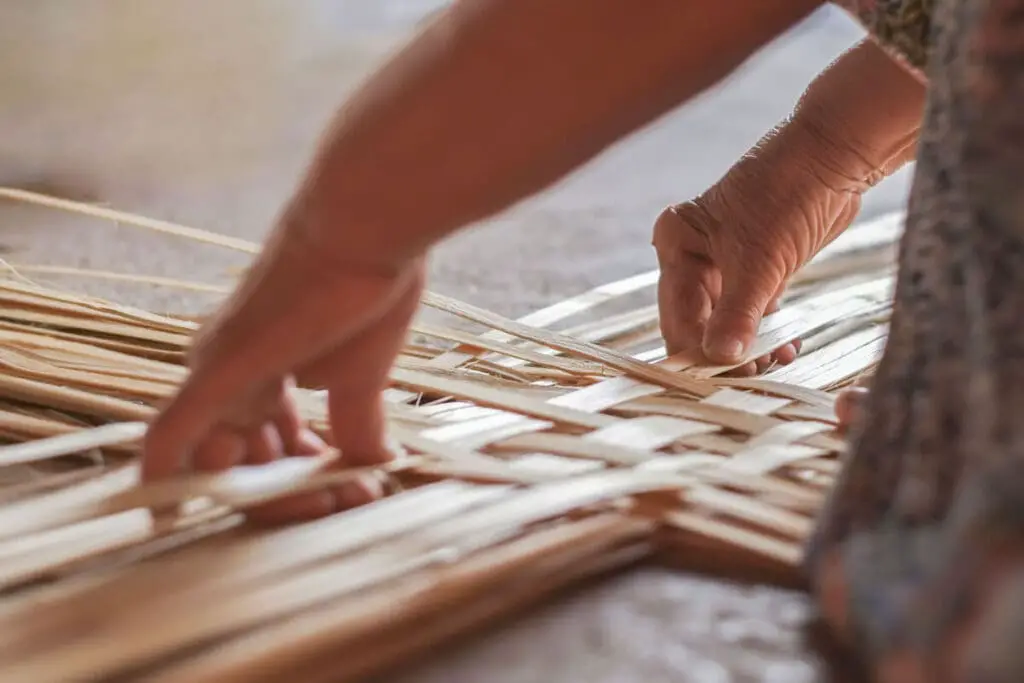
Origins And Physical Structure
Both rattan and bamboo are naturally occurring materials that grow in tropical regions. Rattan is a climbing palm belonging to the Calamoideae subfamily, comprising around 600 species. On the other hand, bamboo belongs to the grass family and boasts over 1,000 different species.
Regarding their physical structure, rattan is solid, with a relatively uniform diameter throughout its length. Bamboo, however, is hollow in the center and has a larger diameter, which tapers down toward the top. This fundamental structural difference significantly impacts their durability, flexibility, and suitability for various applications.
Durability And Flexibility
Rattan is known for its exceptional strength and flexibility, which allows it to be easily shaped and molded into complex designs. When heated, it becomes malleable and can be bent into various shapes.
Once cooled, it retains its new form, resulting in durable and sturdy furniture.
Due to its hollow structure, bamboo is less flexible but still very strong. While it can’t be bent and shaped to the same extent as rattan, it is highly resilient and can withstand considerable weight.
However, it is more prone to splitting than rattan, particularly under pressure or when subjected to harsh environmental conditions.
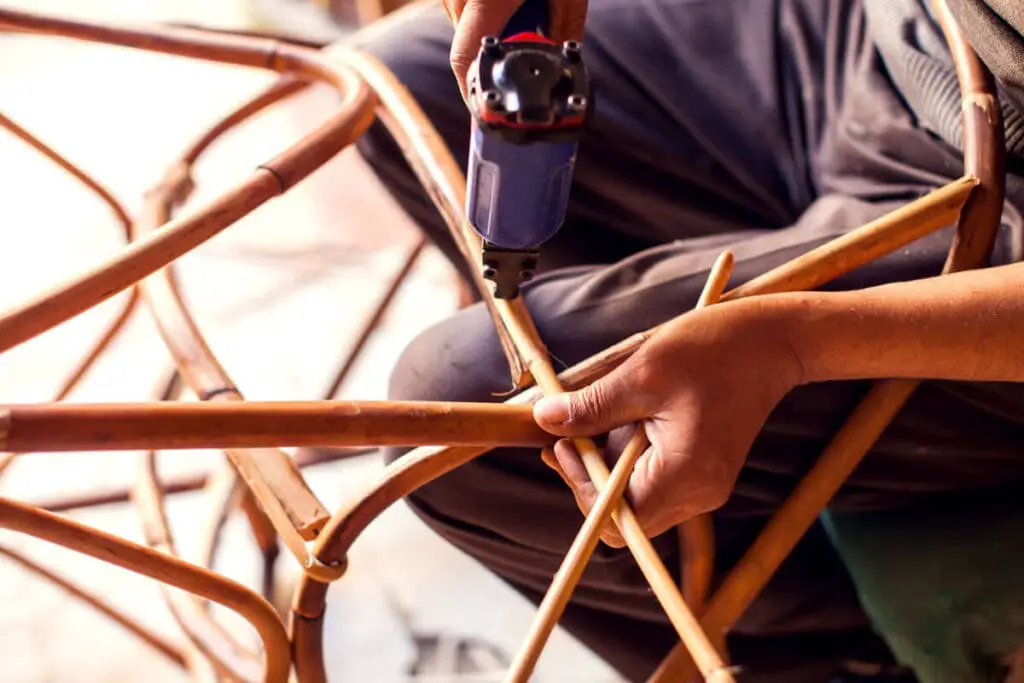
Environmental Impact
Both rattan and bamboo are considered eco-friendly materials due to their rapid growth and renewable nature. They help combat deforestation by providing an alternative to slow-growing hardwoods.
However, the harvesting and production methods can impact their overall environmental footprint. Bamboo often requires minimal processing and can be harvested without killing the plant, making it a highly sustainable option.
Rattan can be harvested sustainably, but improper harvesting techniques can harm the surrounding ecosystems. Ensuring that products made from these materials are sourced from sustainable and responsible producers is essential.
Aesthetic Appeal
Aesthetically, rattan and bamboo bring their unique charm to the table. Rattan is renowned for its warm hue and unique texture, offering a tropical and exotic feel. Its ability to be woven into intricate designs adds to its appeal.
Bamboo, on the other hand, offers a clean and minimalistic aesthetic. Its natural color varies from golden honey to light green, adding a fresh and earthy ambiance to any space.
Both rattan and bamboo have their unique strengths, offering superior flexibility and strength, and bamboo stands out for its sustainability and minimalistic aesthetics.
Your choice will depend on your needs, application, and aesthetic preferences.
Natural Rattan Vs. Synthetic Rattan
The popularity of rattan products has led to the creation of synthetic alternatives, commonly known as synthetic rattan. Made from plastic-based materials, such as PVC, EVA, and PE, synthetic rattan was developed to mimic the look and feel of natural rattan while offering excellent durability and weather resistance.
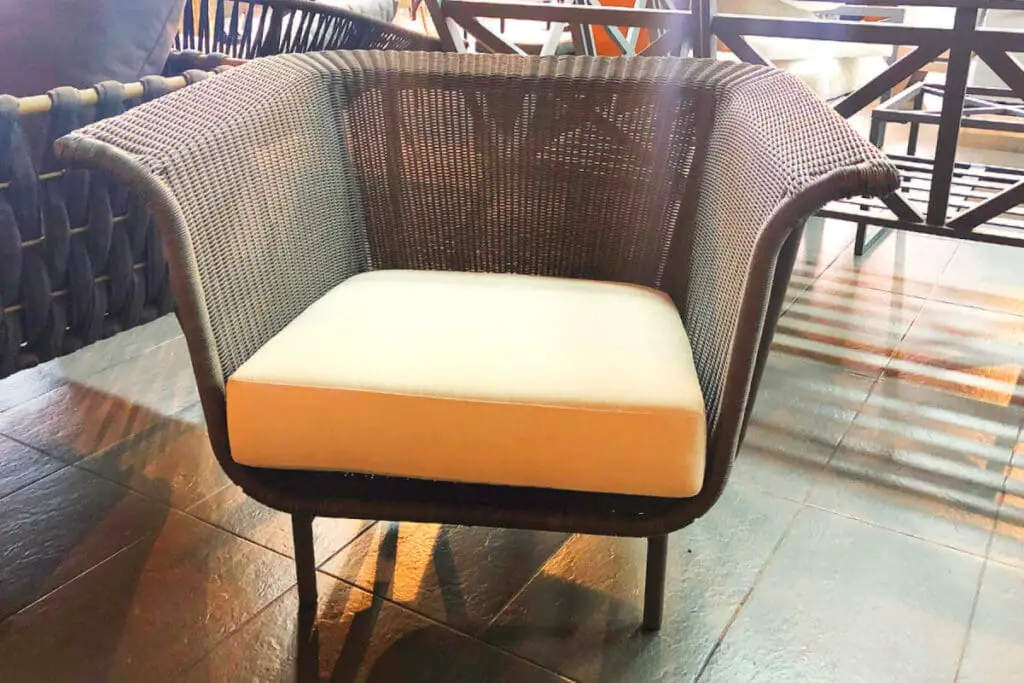
Despite their similarities, there are essential differences between natural and synthetic rattan. One of the most notable differences lies in their environmental impact. Natural rattan is a renewable resource that decomposes naturally at the end of its life.
On the other hand, synthetic rattan is made from non-renewable resources and takes a long time to break down, potentially contributing to environmental pollution.
Another crucial difference lies in the aesthetics. Natural rattan has a unique texture, grain, and warm hue that synthetic rattan struggles to replicate. While synthetic rattan can mimic the look of natural rattan to some extent, it lacks the richness and depth of color that comes from the natural product.
Usage Of Natural And Synthetic Rattan
Synthetic rattan’s durability and weather resistance make it an excellent choice for outdoor furniture. Unlike natural rattan, which can warp or degrade in harsh weather conditions, synthetic rattan can withstand the elements, maintaining its shape and color for years.
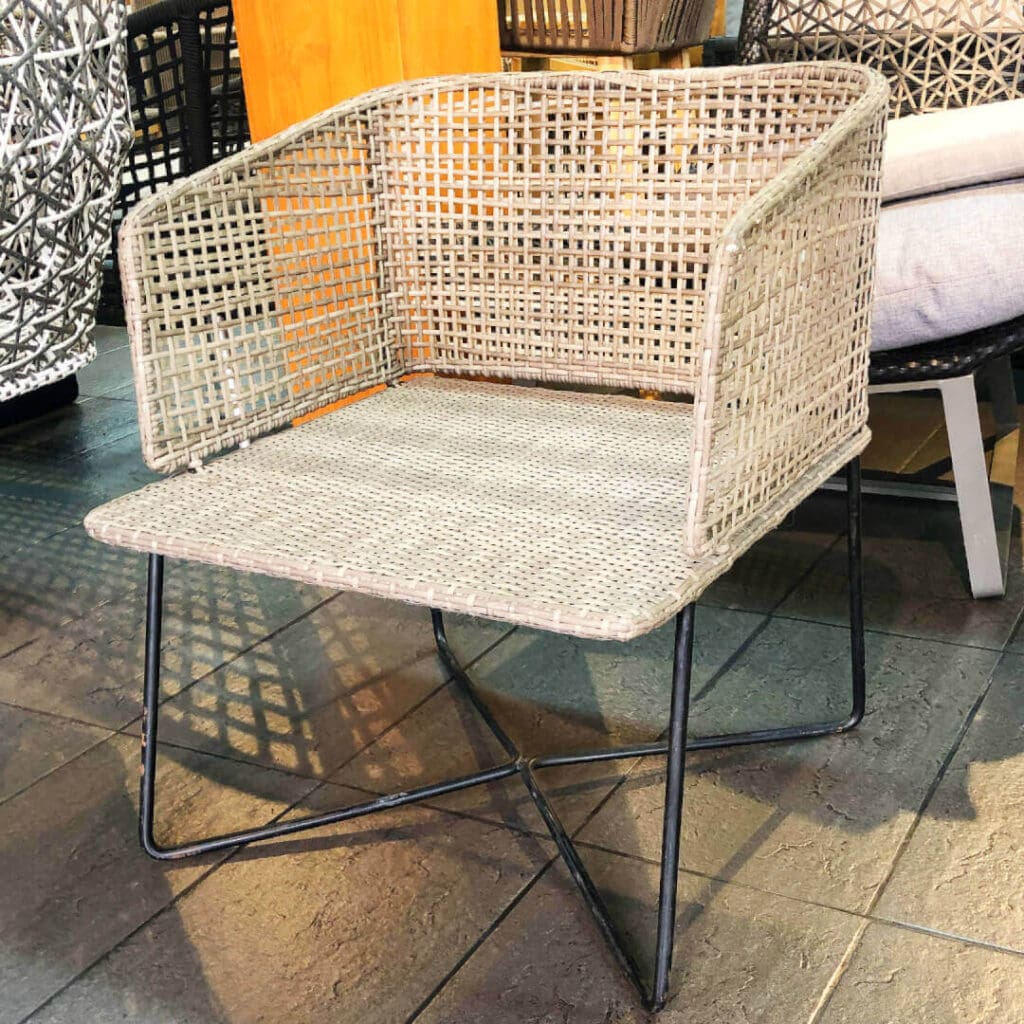
Natural rattan, however, remains the preferred choice for indoor products. The warmth and natural beauty of rattan lend themselves well to interior design, creating a feeling of relaxed elegance.
Natural rattan is a versatile material that enhances any interior setting, from chairs and tables to decorative baskets.
Natural rattan, a product of the climbing palm species found in the rainforests of Africa, Asia, and Australasia, is a unique material valued for centuries for its strength, durability, and beauty.
Synthetic rattan, a durable and weather-resistant alternative, has found its niche in outdoor furniture. At Mondoro, we have used synthetic or faux rattan for many of our outdoor home furniture products.
While these two synthetic and natural rattan materials may seem similar, they offer distinct benefits and drawbacks that make them suitable for different uses.
Whether you choose natural or synthetic rattan, you can be sure that you are selecting a material with a rich history and wide applications. Ultimately, it’s about finding the right balance between practicality, aesthetics, and environmental considerations.
12 Fascinating Facts About Rattan: Nature’s Versatile Wonder
Rattan is a remarkable natural material that has been used for centuries in various forms of craftsmanship and design. From furniture to home decor, rattan’s versatility and eco-friendliness make it a favorite among designers and homeowners alike.
Here are 12 intriguing facts about rattan that shed light on its unique qualities and enduring popularity:
1. Rattan is Not a Tree
Contrary to popular belief, rattan is not a tree; it’s a type of climbing palm. It grows in tropical rainforests and can reach impressive lengths, making it a sustainable resource.
2. Remarkable Strength
Rattan is known for its exceptional strength and durability, making it ideal for crafting sturdy furniture and accessories.
3. Lightweight and Easy to Handle
Despite its strength, rattan is surprisingly lightweight, making it easy to transport and work with.
4. Versatile Crafting Material
Rattan is used in a wide range of products, from chairs and tables to lampshades and baskets. Its versatility knows no bounds.
5. Sustainable and Eco-Friendly
Rattan is a sustainable choice because it regrows rapidly and doesn’t require the same level of deforestation as traditional wood sources.
6. Handwoven Artistry
Many rattan products are handwoven, showcasing the craftsmanship and artistry of skilled artisans.
7. Natural Aesthetic
Rattan’s natural appearance adds warmth and texture to any space, making it a popular choice for bohemian, coastal, and tropical decor styles.
8. Resistance to Elements
Rattan is naturally resistant to wear and tear, as well as humidity and temperature changes, making it suitable for both indoor and outdoor use.
9. Paint and Stain Friendly
Rattan can be easily painted or stained to match various design aesthetics, giving you endless customization options.
10. Historical Significance
Rattan has been used in furniture making for centuries, with historical records dating back to ancient Egypt.
11. Popular in Mid-Century Modern Design
Rattan experienced a resurgence in popularity during the mid-20th century, becoming a staple of the iconic mid-century modern design movement.
12. Sustainable Future
Rattan’s eco-friendly qualities and timeless appeal position it as a material that will likely continue to play a significant role in sustainable design for years to come.
Rattan is a remarkable natural material with a rich history and a bright future in design and craftsmanship. Its strength, versatility, and eco-friendliness make it an excellent choice for those seeking sustainable, stylish, and enduring home decor solutions.
If you are interested in seeing how Mondoro can help you with your rattan furniture and other home decor products – we would love to talk to you about how we can help you.
Find out more about how Mondoro can help you create, develop, and manufacture excellent home decor and furniture products – don’t hesitate to contact me, Anita. Check out my email by clicking here or become a part of our community and join our newsletter by clicking here.
Mondoro gives out a FREE Lookbook to anyone interested. You can receive a copy of our latest Lookbook by clicking here.
Listen to our Podcast called Global Trade Gal. You can find it on all major podcast platforms. Try out listening to one of our podcasts by clicking here.
Subscribe to our Mondoro Company Limited YouTube Channel with great videos and information by clicking here.
Related Content
The Tre Natural Color Trend for Home Decor and Home Furniture
Tre means bamboo. But it also helps to symbolize the strength and ability to be resilient. The Tre trend concerns nature as part of your life and home. The Tre natural color palette has a lot of lush green tones. The Tre trend can be used with other home decor and furniture trends.
You can discover more by reading The Tre Natural Color Trend for Home Decor and Home Furniture by clicking here.
Can Cane Furniture Be Left Outside?
Cane furniture is not outdoor weather-resistant; manufacturers produce outdoor weather-resistant furniture from synthetic, not natural, cane materials. Throughout history, cane furniture was in outdoor settings in many parts of the world; during that time, there was no genuinely outdoor weather-resistant furniture.
You can learn more by reading Can Cane Furniture Be Left Outside? by clicking here.
What Is The Difference Between Rattan, Wicker, And Cane Furniture?
Rattan is a type of palm or vine that grows in the jungles of Southeast Asia. Rattan refers to a kind of natural material. Wicker is a type of weave using rattan materials. Cane also refers to a type of weave that is usually woven using rattan material.
You can learn more by reading our blog What Is The Difference Between Rattan, Wicker, And Cane Furniture? by clicking here.

